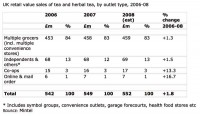 Backed by greater demand for speciality and herbal varieties, the UK retail market for tea and herbal tea managed to post modest growth in 2008 (1% in volume and value) despite a more lacklustre performance by standard tea, which, nevertheless, still accounts for the bulk of sales. While the UK market for tea and herbal tea is currently seeing only moderate growth, household penetration remains high. Today over eight in ten (83%) of Brits enjoy a cuppa, with the majority of us drinking tea several times a day.
Backed by greater demand for speciality and herbal varieties, the UK retail market for tea and herbal tea managed to post modest growth in 2008 (1% in volume and value) despite a more lacklustre performance by standard tea, which, nevertheless, still accounts for the bulk of sales. While the UK market for tea and herbal tea is currently seeing only moderate growth, household penetration remains high. Today over eight in ten (83%) of Brits enjoy a cuppa, with the majority of us drinking tea several times a day.
Alhough standard black tea continues to account for the bulk of sales (92% by volume including decaffeinated versions), it has been outperformed by speciality and herbal teas, with the small segments of green tea and Redbush posting the most dynamic growth. Decaffeinated black tea is gaining ground and is now responsible for some 3% of market volume and 5% of market value.
Both herbal tea and decaffeinated standard tea have grown on the back of consumers’ greater health awareness. Indeed, the health trend is set to continue to have an impact on the market, with consumers also paying increasing attention to ethical trading and environmental friendliness.
Although speciality teas are growing in popularity, the majority of tea drinkers remain somewhat conservative and add herbal alternatives to their drinking repertoire rather than give up standard tea altogether.
While the traditional tea bag continues to account for the lion’s share of sales, square bags are gaining ground at the expense of other formats. In terms of distribution, multiple grocers are responsible for the bulk of tea sales. Online and mail order sales remain limited, but are posting steady year-on-year growth.
Within the traditional tea sector, suppliers have attempted to make standard tea more premium through the launch of special blends, often labelled ‘Gold’ to give an image of luxury, but these teas have had a relatively small impact on the market. This is partly because those in search of the premium tend to opt for single-blend and single-origin speciality teas instead.
While standard tea is a popular beverage amongst 83% of adult Britons – the demographics are pretty even – with main differences being in frequency of drinking rather than penetration. Herbal tea on the other hand has a rather more distinct consumer profile. The core of herbal tea drinkers is formed by women, aged 45-54 followed by those aged 25-34, ABC1s and Londoners. Herbal tea thus has a feminine, affluent and urban appeal. With just 15% of men drinking herbal tea as opposed to 27% of women, it could clearly benefit from some male-specific marketing.
According to Mintel’s excluisve consumer research. The two attributes most closely associated with tea are ‘relaxing’ and ‘healthy’. Whilst standard tea is seen as ‘traditional’ and ‘British’ as well as ‘relaxing’. On the one hand, herbal tea can play on the advantages of relaxing properties of teas such as chamomile. Standard tea on the other hand, gives people psychological comfort in a time of uncertainty. Both types provide the chance for a restorative break, a time to step off the treadmill.
Mintel forecasts a 4% growth in the value of tea over the next five years, with the market reaching £574 million by 2013. In real terms, this is a 5% decrease over the next five years. The outlook for tea looks fair, as Briton’s tea lovers help sector through the tough economic climate.




Comments are closed.